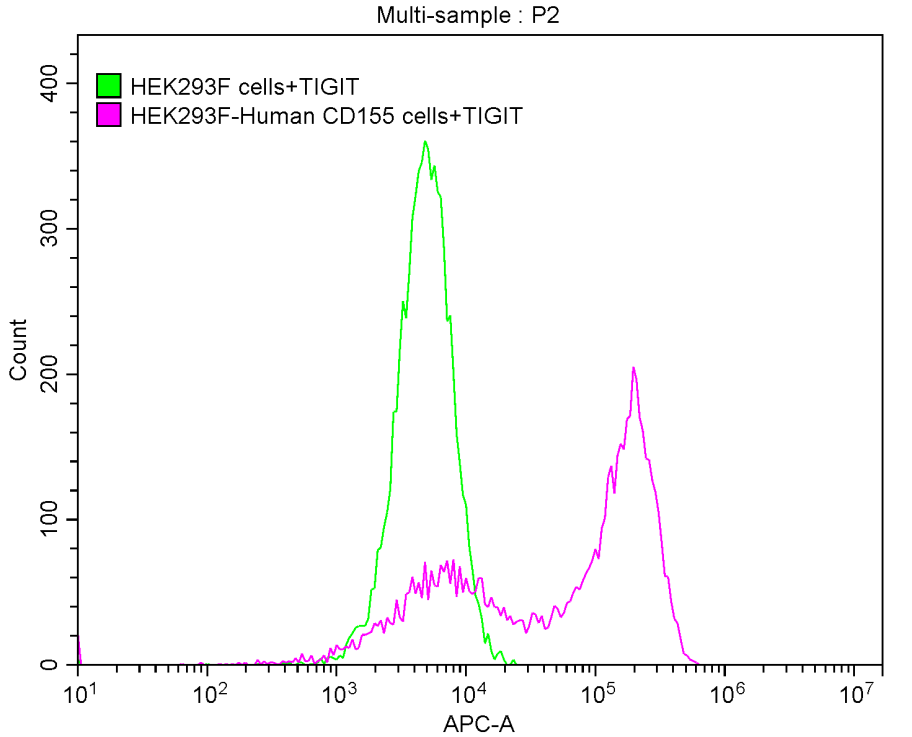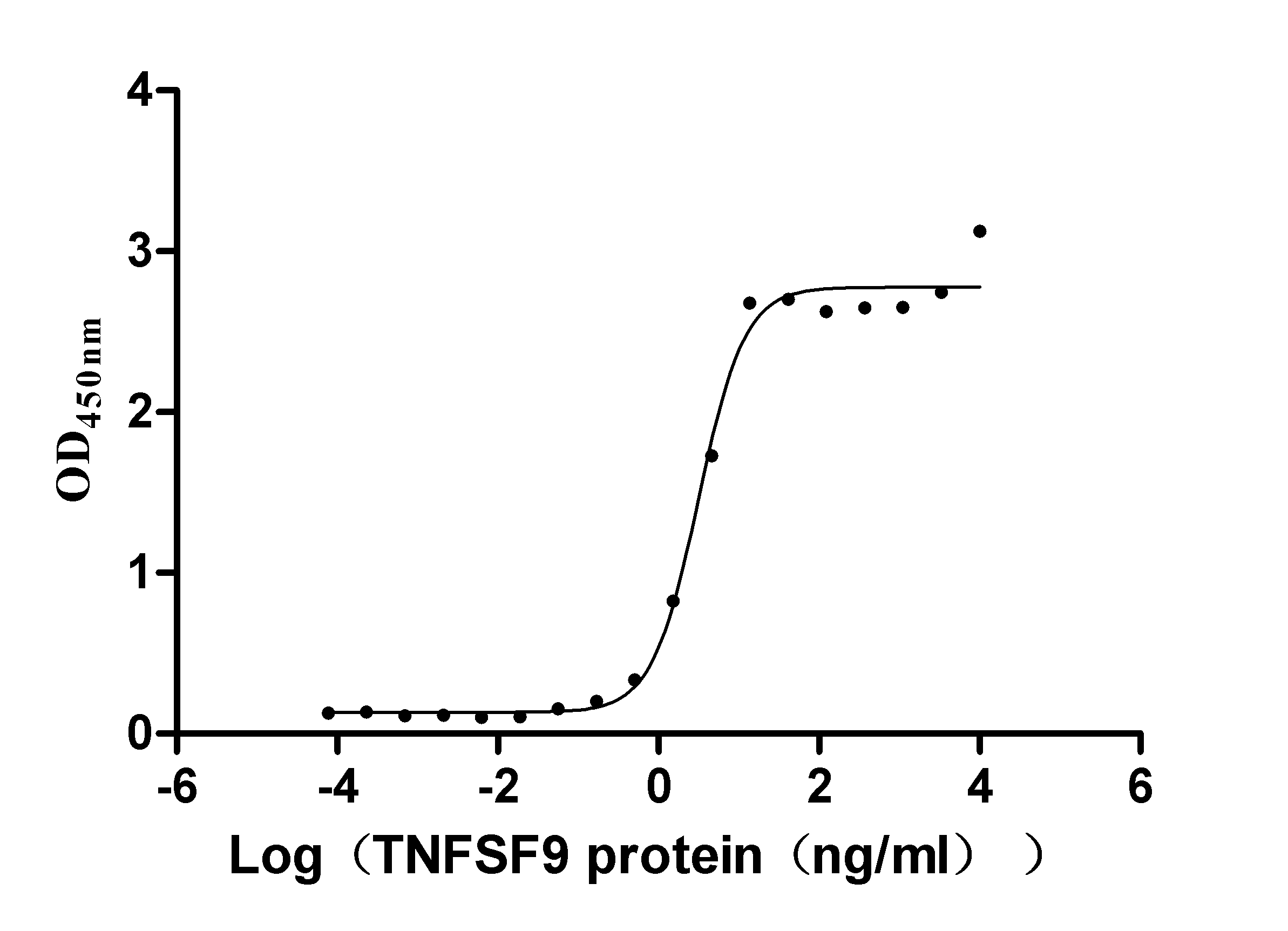Recombinant Mouse Somatostatin receptor type 2 (Sstr2)
-
货号:CSB-CF022725MO
-
规格:
-
来源:in vitro E.coli expression system
-
其他:
产品详情
-
基因名:
-
Uniprot No.:
-
别名:Sstr2; Smstr2; Sst2; Somatostatin receptor type 2; SS-2-R; SS2-R; SS2R; SRIF-1
-
种属:Mus musculus (Mouse)
-
蛋白长度:Full length protein
-
表达区域:1-369
-
氨基酸序列MEMSSEQLNGSQVWVSSPFDLNGSLGPSNGSNQTEPYYDMTSNAVLTFIYFVVCVVGLCG NTLVIYVILRYAKMKTITNIYILNLAIADELFMLGLPFLAMQVALVHWPFGKAICRVVMT VDGINQFTSIFCLTVMSIDRYLAVVHPIKSAKWRRPRTAKMINVAVWCVSLLVILPIMIY AGLRSNQWGRSSCTINWPGESGAWYTGFIIYAFILGFLVPLTIICLCYLFIIIKVKSSGI RVGSSKRKKSEKKVTRMVSIVVAVFIFCWLPFYIFNVSSVSVAISPTPALKGMFDFVVIL TYANSCANPILYAFLSDNFKKSFQNVLCLVKVSGTEDGERSDSKQDKSRLNETTETQRTL LNGDLQTSI
Note: The complete sequence including tag sequence, target protein sequence and linker sequence could be provided upon request. -
蛋白标签:N-terminal 10xHis-tagged
-
产品提供形式:Liquid or Lyophilized powder
Note: We will preferentially ship the format that we have in stock, however, if you have any special requirement for the format, please remark your requirement when placing the order, we will prepare according to your demand. -
缓冲液:Lyophilized from Tris/PBS-based buffer, 6% Trehalose, pH 8.0
-
储存条件:Store at -20°C/-80°C upon receipt, aliquoting is necessary for mutiple use. Avoid repeated freeze-thaw cycles.
-
保质期:The shelf life is related to many factors, storage state, buffer ingredients, storage temperature and the stability of the protein itself.
Generally, the shelf life of liquid form is 6 months at -20°C/-80°C. The shelf life of lyophilized form is 12 months at -20°C/-80°C. -
货期:Basically, we can dispatch the products out in 1-3 working days after receiving your orders. Delivery time may differ from different purchasing way or location, please kindly consult your local distributors for specific delivery time.Note: All of our proteins are default shipped with normal blue ice packs, if you request to ship with dry ice, please communicate with us in advance and extra fees will be charged.
-
注意事项:Repeated freezing and thawing is not recommended. Store working aliquots at 4°C for up to one week.
-
Datasheet & COA:Please contact us to get it.
相关产品
靶点详情
-
功能:Receptor for somatostatin-14 and -28. This receptor is coupled via pertussis toxin sensitive G proteins to inhibition of adenylyl cyclase. In addition it stimulates phosphotyrosine phosphatase and PLC via pertussis toxin insensitive as well as sensitive G proteins. Inhibits calcium entry by suppressing voltage-dependent calcium channels. Acts as the functionally dominant somatostatin receptor in pancreatic alpha- and beta-cells where it mediates the inhibitory effect of somatostatin-14 on hormone secretion. Inhibits cell growth through enhancement of MAPK1 and MAPK2 phosphorylation and subsequent up-regulation of CDKN1B. Stimulates neuronal migration and axon outgrowth and may participate in neuron development and maturation during brain development. Mediates negative regulation of insulin receptor signaling through PTPN6. Inactivates SSTR3 receptor function following heterodimerization.
-
基因功能参考文献:
- Both hippocampal sst2 and sst4 receptors selectively inhibit stress-induced HPA axis activation but mediate anxiolytic and antidepressive effects through distinct mechanisms. PMID: 27986975
- Loss of sst2 from pancreatic tissues activates PI3K signaling via AKT, leading to activation of NF-kappaB, amplification of oncogenic KRAS signaling, increased expression of CXCL16, and pancreatic tumor formation. PMID: 25683115
- SST2 expression protects against gentamicin-induced auditory hair cell loss in the mammalian inner ear. PMID: 25268135
- Knock-down of SSTR2 leads to loss of pluripotency in murine embryonic stem cells. PMID: 24998255
- Inhibition of the Sstr2 receptor reversed the anticonvulsant effect mediated by cortistatin-14. PMID: 24685142
- OCT-P407 induces mRNA expression of SSTR-2 and caspase-3 and decreases that of VEGF in mice. PMID: 24173662
- The study encourages the use of liver tissue SSR2 protein and mRNA as a reliable tumor marker for liver cancer PMID: 24163059
- The aim of this study was to validate an animal model expressing SSTR2 and to correlate the immunohistochemical (IHC) analysis with (18)F-FDG and (68)Ga-DOTATOC uptake in vivo. PMID: 23898054
- SSTR2 was expressed in Kolliker's organ on E14, on cochlear duct hair cells & supporting cells on E17 and only on the organ of Corti at birth, increasing & peaking at P14 but dropping off at P21. PMID: 22986312
- SSTR2 was well expressed in most of the hypothalamic regions whereas it decreases significantly in ventromedial and arcuate nucleus of ApoD(-/-) mice. PMID: 22581439
- sst2 may protect retinal cells from hypoxia, thus implementing the background to establish potential pharmacological targets. PMID: 22311350
- somatostatin receptors demonstrate specific expression in HCs and supporting cells of the mouse cochlea, and that absence of SST1 alters the expression of SST2. PMID: 21896184
- SSTR2-based reporters can serve as reporters of gene transfer into non-small cell lung cancer. PMID: 20653396
- Overexpressed in endomterium inendometriosis. PMID: 20739383
- sst(2a) and sst(4) were respectively detected in the dentate gyrus (DG) and the CA1 subfield suggesting that their functional interactions are not mediated by direct receptor coupling PMID: 19623609
- Data indicate that OcF showing high-affinity binding to the sstr2. PMID: 20233796
- sst(2) receptors mediate inhibition of peristalsis in the jejunum PMID: 11897621
- The somatostatin receptor subtype 2a (SSR(2(a))) was found in the cytoplasm and the plasma membrane of catecholaminergic CAD-cells. After serum deprivation, SSR(2(a)) was up-regulated in the cells. PMID: 12441163
- Somatostatin 2 receptors are expressed in neurons and endocrine cells in the stomach and the small and large intestine. PMID: 12442323
- Sst2 activation inhibits the AMPA component of glutamatergic synaptic responses. Decrease of AMPA currents induced by octreotide requires a concomitant activation of sst2 receptors with either NMDA and/or metabotropic glutamate receptors. PMID: 12509482
- omatostatin regulates ductal bile formation in mice by inhibition of ductal fluid secretion, also by stimulation of ductal fluid absorption via interacting with SSTR2 on cholangiocytes, a process involving the intracellular cAMP/cGMP second messengers. PMID: 12676656
- In the striatum, Sstr2 expression is identified in medium spiny projection neurons restricted to the matrix compartment and in cholinergic interneurons. PMID: 12752788
- Evidence is provided that the overexpression of sst2 receptors has a profound impact on the sst2-mediated modulation of membrane excitability and neurotransmitter release in the mouse retina. PMID: 15464758
- somatostatin receptor subtype-2 is responsible for somatostatin binding in cortical and amygdaloid regions PMID: 15544857
- We provide direct evidence for activation of SSTR2 by an endogenous ligand after focal ischemia, which contributes to increased SSTR2 gene expression and postischemic neurodegeneration. PMID: 15601946
- role of somatostatin receptor subtype 5 on somatostatin receptor subtype 2 action in pituitary tumor cells PMID: 15857828
- the presence of sst(5) in the same cells modulates trafficking and cell surface regulation of sst(2A) and cellular desensitization to the effects of SRIF PMID: 17272399
- sst2 deficiency is associated with exaggerated jejunal afferent sensitivity to mechanical/chemical stimulation, suggesting that somatostatin plays an inhibitory role to control visceral sensitivity by interacting with the sst2 receptor. PMID: 17363388
- Decreased afferent responses to somatostatin receptor 2 stimulation correlated with lower expression of vagal somatostatin receptor 2 in stressed Nb-infected mice, confirming a link between molecular data and functional sequelae. PMID: 17408648
- Increased glucagon concentration is associated with impaired glucose control in sst2(-/-) mice, resulting from decreased hepatic glucose storage, increased glycogen breakdown, and reduced lipid accumulation PMID: 17525126
- Acute EAE disrupts the rat striatal SRIF receptor-effector system, providing insight into the molecular basis of EAE, leading to a better understanding of human multiple sclerosis. PMID: 17630220
- sst(2) may be protective against retinal angiogenesis PMID: 17652715
- The functional interactions between human somatostatin receptor 2 (hSSTR2) and human dopamine receptor 2 (hD2R) in both co-transfected CHO-K1 or HEK-293 cells as well as in cultured neuronal cells which express both the receptors endogenously. PMID: 17706924
- there is a remodeling of the neuroendocrine mechanisms that regulate acid secretion in mutant mice lacking SSTR2 PMID: 17974627
- Data show that a reconsideration of the role of SSTR2 in the GI somatostatinergic effects is in order and further corroborate recent data on the role of other SSTR subtypes in the inflammatory effects of SOM during intestinal inflammation. PMID: 18298437
- The somatostatin type 2A receptor is mobile and rapidly and laterally diffuses in hippocampal neuronal membranes. PMID: 18434512
- SSTR2 is the predominant mediator of functional ocular antiangiogenic effects. PMID: 18599562
- These results demonstrate that sst(2) activation protects against retinal ischaemia. However, in the presence of sst(2) over-expression sst(2) is functionally desensitised by agonists, possibly because of sustained RGS1 levels. PMID: 18624922
- These results suggest that, in the adult mouse, testosterone is a major modulator of sst2A distribution on GHRH neurones. PMID: 18752655
显示更多
收起更多
-
亚细胞定位:Cell membrane; Multi-pass membrane protein. Cytoplasm.
-
蛋白家族:G-protein coupled receptor 1 family
-
组织特异性:Cerebrum and kidney.
-
数据库链接:
KEGG: mmu:20606
STRING: 10090.ENSMUSP00000068578
Most popular with customers
-
Recombinant Human T-cell immunoreceptor with Ig and ITIM domains (TIGIT), partial (Active)
Express system: Mammalian cell
Species: Homo sapiens (Human)
-
Recombinant Human Tumor necrosis factor ligand superfamily member 9 (TNFSF9), partial (Active)
Express system: Mammalian cell
Species: Homo sapiens (Human)
-
Recombinant Human Insulin growth factor-like family member 1 (IGFL1) (Active)
Express system: Mammalian cell
Species: Homo sapiens (Human)
-
Recombinant Human Complement component C1q receptor (CD93), partial (Active)
Express system: Mammalian cell
Species: Homo sapiens (Human)
-
Recombinant Human Interleukin-2 (IL2) (Active)
Express system: Mammalian cell
Species: Homo sapiens (Human)
-
Recombinant Human Myosin regulatory light chain 12B(MYL12B) (Active)
Express system: E.coli
Species: Homo sapiens (Human)
-
Recombinant Human C-C chemokine receptor type 6(CCR6)-VLPs (Active)
Express system: Mammalian cell
Species: Homo sapiens (Human)



















